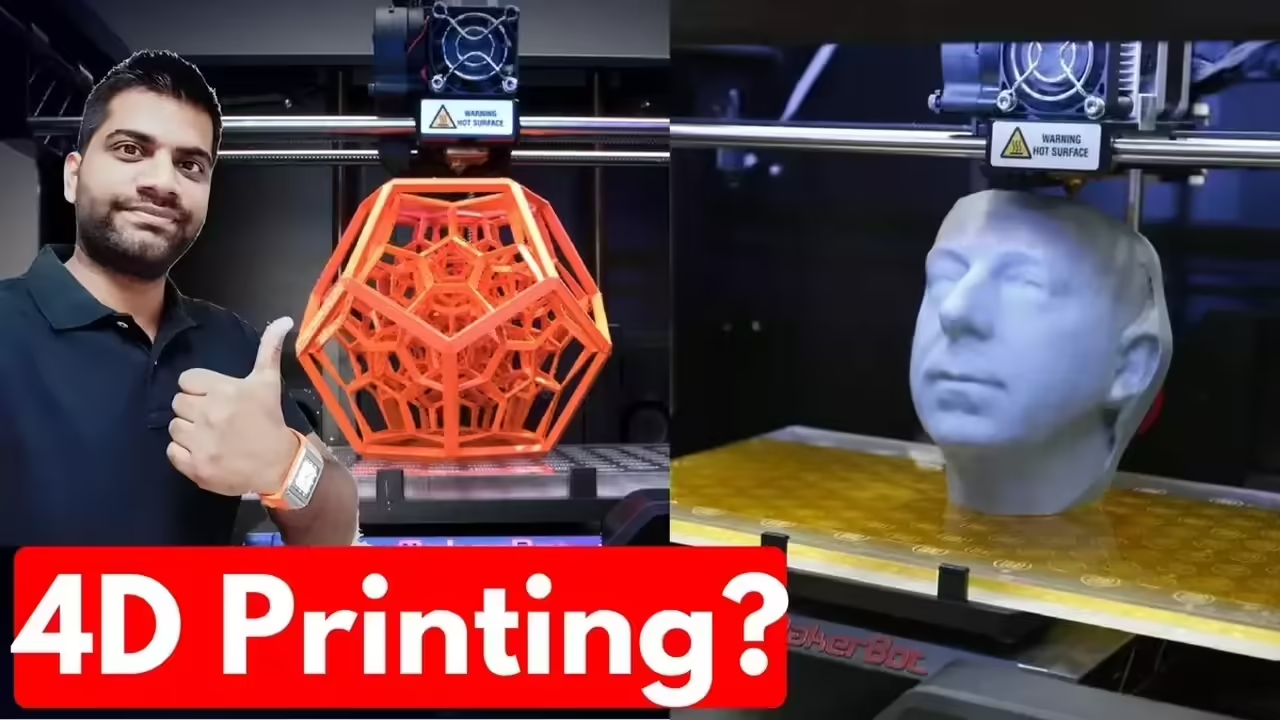
3D printing has revolutionized the way we manufacture objects, allowing us to create everything from prototypes to final products quickly and in a customized way. However, the technology doesn’t stop there. Now, we are witnessing the advent of 4D printing, a leap into the future of manufacturing that promises to take the customization and functionality of objects to a whole new level.
4D printing is an extension of 3D printing that adds an additional dimension: time. Unlike conventional 3D printing, where objects are printed in static layers, 4D printing uses smart materials capable of changing their shape, structure or function after being printed, in response to external stimuli such as heat, light or humidity.
The key to 4D printing lies in materials known as “active polymers” or “programmable polymers.” These materials are designed with specific properties that allow them to respond to stimuli and alter their shape or function in a controlled manner. For example, a 4D-printed object can fold, expand, contract or even assemble itself when exposed to certain environmental conditions.
This self-transforming capability of 4D printed objects has significant implications in a wide range of industries. For example, in the medical industry, 4D printing could revolutionize customized implants and prosthetics. 4D-printed implants could be perfectly tailored to each patient’s unique anatomy, and could also change their shape or release drugs in a controlled manner as the body recovers.
In the field of architecture and construction, 4D printing could enable the creation of self-assembling structures. Imagine buildings that construct themselves as 4D-printed materials react and assemble in response to specific signals. This would not only speed up the construction process, but also open up new possibilities in terms of design and structural flexibility.
In addition to medicine and architecture, 4D printing also has the potential to revolutionize the manufacturing of consumer products, aerospace, automotive and many other industries. 4D printed objects could adapt to users’ changing needs, reducing waste and maximizing efficiency.
However, despite all the promise and potential of 4D printing, there are still technical and research challenges to overcome. 4D printing requires the development of new materials, manufacturing methods and advanced design software. In addition, the scalability and economic feasibility of this technology are also important considerations.
As research and development continues, it is exciting to contemplate the future of manufacturing with 4D printing. This technological breakthrough has the potential to transform the way we produce and use objects in our daily lives. Customization and adaptability will be the main drivers of 4D printing, giving people the ability to create products that perfectly fit their individual needs.
4D printing can also have a significant impact on sustainability. By enabling on-demand manufacturing and the ability to customize objects, mass production and material waste will be reduced. This can lead to a decrease in carbon footprint and more efficient use of natural resources.
As 4D printing technology advances, ethical and legal challenges will also arise. The ability to create objects that change their form or function raises questions about the liability and safety of such products. Appropriate regulations and standards will need to be established to ensure the quality and safety of 4D printed objects.
Applications of 4D printing in medicine
4D printing is proving to have great potential in the medical industry, offering new ways to address challenges and revolutionize medical treatments and procedures. Below, we will explore some of the most exciting applications of 4D printing in medicine:
Custom prosthetics – 4D printing enables the fabrication of personalized prosthetics that are precisely tailored to each patient’s unique anatomy. The smart materials used in 4D printing can adjust and adapt as the patient moves, providing increased comfort and functionality.
Active implants: 4D-printed implants can respond to specific stimuli in the body, such as heat or moisture. This enables the controlled release of drugs or therapeutic substances at the right place and time, improving the effectiveness of treatments and speeding recovery.
Bioprinted tissues and organs: 4D printing in medicine is also paving the way for the bioprinting of tissues and organs. Researchers are working on printing complex structures that mimic the architecture and functions of living tissues. These advances could have a significant impact on regenerative medicine, enabling the creation of artificial organs for transplantation and reducing reliance on donations.
Adaptive medical devices: 4D printing enables the manufacture of adaptive medical devices, such as stents or vascular grafts, which can change their shape or size to suit the patient’s needs. This facilitates surgical procedures and reduces the need for multiple interventions.
Surgical simulation and planning: 4D printing is also used to create accurate anatomical models from medical imaging data, enabling more precise surgical planning and better communication between medical teams and patients. These 4D printed models allow surgeons to practice complex procedures and evaluate potential outcomes prior to actual surgery.
4D printing in the construction industry
4D printing is beginning to have a significant impact on the construction industry, offering new possibilities in terms of design, efficient construction and sustainability. Below, we will explore how 4D printing is being used in the construction of complex architectural structures:
Fabrication of structural components: 4D printing enables the fabrication of complex structural components in an efficient manner. The smart materials used in 4D printing can change their shape or function in response to certain stimuli, making it possible to create structural elements that automatically adapt and adjust to environmental loads and conditions.
Self-assembling construction: One of the most exciting features of 4D printing in construction is the ability to create self-assembling structures. By using 4D printed materials that can change their shape and fit together, it is possible to have structures automatically assemble themselves without the need for additional labor. This has the potential to speed up the construction process and reduce associated costs.
Customization and adaptability: 4D printing enables the customization and adaptability of architectural structures. 4D printed objects can adjust to changing user needs or environmental conditions. For example, facades can be printed that open or close in response to sunlight or structural elements that expand or contract to accommodate load changes.
Waste reduction and efficient use of materials: 4D printing can help reduce construction waste by printing only the exact amount of material required for the structure. This is in contrast to traditional construction methods, where large amounts of waste are often generated. In addition, 4D printing allows for more efficient use of materials, as only the necessary materials are used, avoiding excess and unnecessary waste.
Designing complex shapes: 4D printing enables the creation of complex architectural shapes that would be difficult or costly to achieve with conventional construction methods. This opens up new possibilities in terms of architectural design and enables the creation of innovative and aesthetically appealing structures.
4D printing in fashion and apparel design
4D printing is beginning to make waves in the fashion and apparel design industry, offering designers an innovative tool to create unique garments and accessories that defy the limitations of traditional methods. Below, we will explore how 4D printing is being used in the world of fashion and apparel design:
Designing complex shapes: 4D printing allows designers to explore new shapes and structures that were previously difficult to achieve. By using smart, flexible materials, garments can be printed with unique three-dimensional elements, textures and patterns. This results in more intriguing and original designs.
Customization and customizability: 4D printing allows for the personalization of garments. Designers can print garments that perfectly fit the shape and measurements of the wearer, offering a more precise and comfortable fit. In addition, the smart materials used in 4D printing can respond to external stimuli, such as movement or body temperature, adapting the garment to the wearer’s needs and preferences.
Integration of additional functions: 4D printing enables the integration of additional functions into garments. For example, garments can be printed with built-in pockets or compartments, protective elements or even wearable technology. This opens up new possibilities in terms of functionality and usability in clothing.
Movement and transformation: 4D printing enables the creation of garments that can change their shape, structure or appearance in response to certain stimuli. For example, garments can be printed that expand, fold or change color in response to light or heat. This adds a dynamic and surprising element to fashion creations, creating garments that transform and adapt to the environment or the wearer’s mood.
Sustainability and waste reduction: 4D printing in fashion has the potential to reduce material waste and make production more sustainable. By printing garments accurately and efficiently, excess fabric and material waste can be minimized, contributing to more environmentally responsible fashion.
4D printing in the automotive industry
4D printing is beginning to have a significant impact on the automotive industry, providing new opportunities for the manufacture of lighter, stronger and more customized parts and components. Below, we will explore how 4D printing is being used in the automotive industry:
Custom part manufacturing: 4D printing enables the manufacture of customized automotive parts and components that are tailored to the specific needs of each vehicle or customer. Materials used in 4D printing can be adjusted and tailored to meet unique performance and design requirements, resulting in more efficient and functional parts.
Reduced weight and improved performance: 4D printing enables the creation of lighter automotive parts without compromising strength and durability. By printing components with optimized internal structures and complex geometries, materials and overall vehicle weight can be reduced. This can result in improved performance, increased fuel efficiency and reduced emissions.
Integration of functions and reduced assembly: 4D printing enables the integration of multiple functions into a single part, reducing the need for assembly of multiple components. For example, parts can be printed that combine shock absorption, structural strength and thermal conductivity characteristics in a single component. This not only simplifies the manufacturing process, but also reduces weight and improves vehicle efficiency.
Rapid prototyping and agile development: 4D printing is especially useful in the automotive product development stage, as it enables rapid prototyping and rapid design iteration. Automakers can print functional prototypes and test their performance before moving to mass production. This speeds development time and reduces costs associated with traditional prototyping.
Part repair and replacement: 4D printing is also used for repair and replacement of damaged automotive parts. Instead of waiting for replacement parts to arrive, shops can print the necessary parts on demand, reducing downtime and costs associated with vehicle maintenance and repair.







